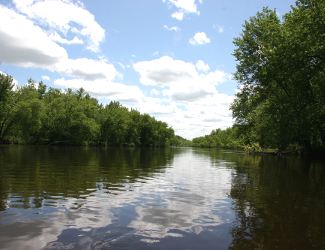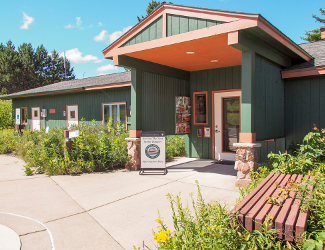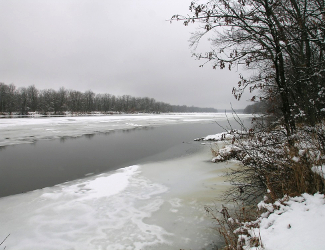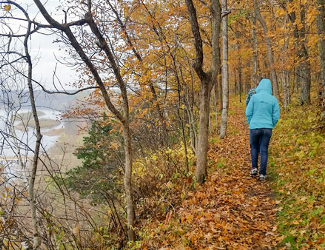
Photo above: Rafting near the East Iron Bridge near Earl over the Namekagon River, 1995, Historic American Buildings Survey. Courtesy Library of Congress. Photo right: Flowage caused by the dam near St. Croix Falls, Wisconsin. Courtesy National Park Service.

Saint Croix National Scenic Riverway
Yes, this river eventually finds its way to the Mississippi, just as its smaller cousin, the Namekagon, which is also a part of the park, does as well. While most who traverse the water and trails of the Saint Croix park will do so for the recreation of craft or feet, just above the bluffs, there is history of the Woodland people, from mounds to heritage that make the Saint Croix and Namekagon waterways not only a highway today for recreation, but one, in the past, that was essential to life and sustenance. Saint Croix NSR has been around awhile though for that river protection and recreation. It is the oldest National Scenic River, established in 1968 by President Johnson.
Click here to Sponsor the page and how to reserve your ad.
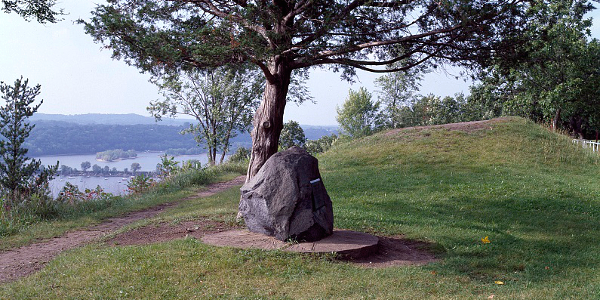
Saint Croix NSR Then
Long before Europeans invaded the north woods of the Saint Croix and Namekagon Rivers in 1831 during the Henry Schoolcraft Expedition, or even before that in the late 1600's when French cartographer Jean-Baptiste-Louis Franquelin, in 1688, created a map which named the area Saint Croix, the Ojibwe, Fox, Dakota, and other Woodland tribes built villages and life all along the waterway. They were semi-nomadic, traveling throughout the area at different times of the year; spring sugar bush camps, fish camps in summer, and wild rice camps in the fall. At sites such as Riverside Landing, Sandstone Cliffs, and Ridge View, archaeologists have found evidence of the heritage and culture. On the bluffs above the Saint Croix River, it is estimated that over fifteen thousand mounds were built by the Woodland tribes.
Once the Europeans invaded the riverway and negotiated a Treaty with the Ojibwe that allowed settlement from 1837 forward, the fur trade, followed by timber, dominated the area. This continued in earnest through 1914. The Ojibwe (Chippewa) controlled nearly all of Michigan, north Wisconsin, and Minnesota, plus westward to the North Dakota Turtle Mountains from the late 18th century forward until European settlement.
Photo above: One of mounds built by the Woodland people on the sandstone cliffs of the Saint Croix River, 1980-2006, Carol M. Highsmith. Courtesy Library of Congress. Below: Saint Croix River near Stevens Creek. Courtesy National Park Service.

Saint Croix River NSR Now
On October 2, 1968, President Lyndon B. Johnson and Congress established the National Wild and Scenic Rivers Act. It protected portions of eight rivers, including the Saint Croix. Today, two hundred and fifty-two miles of the river and its tributaries exist under the National Park Service and other entities to provide recreation and ecology.
Today, you can also fish for smallmouth bass, recreate on a kayak, boat, or canoe, and spend the day and night along the rivers and their banks. The National Scenic Riverway is far from the only entity protecting the Saint Croix and Namekagon Rivers. In Minnesota, there's Saint Croix State Forest, Saint Croix State Park, Chengwatana State Forest, Wild River State Park, Williams O'Brien State Park, St. Croix Boom Site, Afton State Park, and St. Croix Bluffs Regional Park. In Wisconsin, there's Governor Knowles State Forest and Kinnickinnic State Park. Interstate Park shares both states.
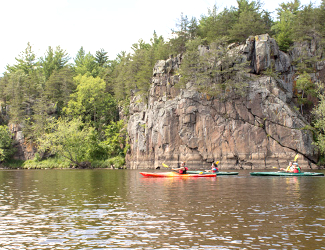
Saint Croix River NSR
Things You Should Not Miss
1. There are a variety of Ranger Programs that should not be missed if you get the chance. The Afternoon or Evening Stillwater Tour on a pontoon boat is one of the favorites. It has limited seating, only twelve, and must be booked in advance.
2. Take a hike. So many trails, so little time, and many with a spectacular view of the water. On the Park Service grounds, there are seven trails. More exist in the state and country parks along the two hundred miles of riverside. One of the favorites, the Sandrock Cliff Trails includes sandstone created during the Ice Age from the sea. There's five miles of trails in that area.
3. Head to the water. Seems obvious, we realize, but in a park devoted to a riverway, the opportunity to kayak, canoe, fish, and boat are all over the Saint Croix and Namekagon Rivers. Check at the Visitor Center for the best places to do what you like best and heed all rules and regulations so your visit is safe and fun.
Photo above: Kayaking in Saint Croix NSR. Courtesy National Park Service/Tatenhove.
T-Shirts and Souvenirs

Saint Croix National Scenic River and other National Park T-Shirts and Gifts from the official souvenirs of America's Best History. Great for nature, national park, and heritage history fans.
